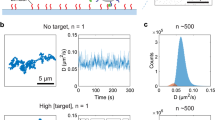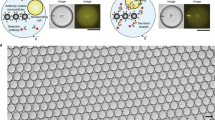Abstract
Fluorescent-sandwich immunoassays on microarrays hold appeal for proteomics studies, because equipment and antibodies are readily available, and assays are simple, scalable, and reproducible. The achievement of adequate sensitivity and specificity, however, requires a general method of immunoassay amplification. We describe coupling of isothermal rolling-circle amplification (RCA) to universal antibodies for this purpose. A total of 75 cytokines were measured simultaneously on glass arrays with signal amplification by RCA with high specificity, femtomolar sensitivity, 3 log quantitative range, and economy of sample consumption. A 51-feature RCA cytokine glass array was used to measure secretion from human dendritic cells (DCs) induced by lipopolysaccharide (LPS) or tumor necrosis factor-α (TNF-α). As expected, LPS induced rapid secretion of inflammatory cytokines such as macrophage inflammatory protein (MIP)-1β, interleukin (IL)-8, and interferon-inducible protein (IP)-10. We found that eotaxin-2 and I-309 were induced by LPS; in addition, macrophage-derived chemokine (MDC), thymus and activation-regulated chemokine (TARC), soluble interleukin 6 receptor (sIL-6R), and soluble tumor necrosis factor receptor I (sTNF-RI) were induced by TNF-α treatment. Because microarrays can accommodate ∼1,000 sandwich immunoassays of this type, a relatively small number of RCA microarrays seem to offer a tractable approach for proteomic surveys.
This is a preview of subscription content, access via your institution
Access options
Subscribe to this journal
Receive 12 print issues and online access
$209.00 per year
only $17.42 per issue
Buy this article
- Purchase on Springer Link
- Instant access to full article PDF
Prices may be subject to local taxes which are calculated during checkout





Similar content being viewed by others
References
Bussow, K. et al. A method for global protein expression and antibody screening on high-density filters of an arrayed cDNA library. Nucleic Acids Res. 26, 5007–5008 (1998).
Leuking, A. et al. Protein microarrays for gene expression and antibody screening. Anal. Biochem. 270, 103–111 (1999).
Ge, H. UPA, a universal protein array system for quantitative detection of protein–protein, protein–DNA, protein–RNA and protein–ligand interactions. Nucleic Acids Res. 28, e3 (2000).
de Wildt, R.M.T., Mundy, C.R., Gorick, B.D. & Tomlinson, I.M. Antibody arrays for high-throughput screening of antibody–antigen interactions. Nat. Biotechnol. 18, 989–994 (2000).
MacBeath, G. & Schreiber, S.L. Printing proteins as microarrays for high-throughput function determination. Science 289, 1760–1763 (2000).
Zhu, H. et al. Global analysis of protein activities using proteome chips. Science 293, 2101–2105 (2001).
Mendoza, L.G. et al. High-throughput microarray-based enzyme-linked immunoabsorbant assay (ELISA). Biotechniques 27, 778–788 (1999).
Holt, L.J., Enever, C., de Wildt, R.M. & Tomlinson, I.M. The use of recombinant antibodies in proteomics. Curr. Opin. Biotechnol. 11, 445–449 (2000).
Hanes, J., Schaffitzel, C., Knappik, A. & Pluckthun, A. Picomolar affinity antibodies from a fully synthetic naive library selected and evolved by ribosome display. Nat. Biotechnol. 18, 1287–1292 (2000).
Lohse, P.A. & Wright, M.C. In vitro protein display in drug discovery. Curr. Opin. Drug Discov. Devel. 4, 198–204 (2001).
Nord, K., Gunneriusson, E., Uhlén, M. & Nygren, P.-Å. Ligands selected from combinatorial libraries of protein A for use in affinity capture of apolipoprotein A-1M and Taq DNA polymerase. J. Biotechnol. 80, 45–54 (2000).
Wiese, R., Belosludtsev, Y., Powdrill, T., Thompson, P. & Hogan, M. Simultaneous multianalyte ELISA performed on a microarray platform. Clin. Chem. 47, 1451–1457 (2001).
Moody, M.D., Van Arsdell, S.W., Murphy, K.P., Orencole, S.F. & Burns, C. Array-based ELISAs for high-throughput analysis of human cytokines. Biotechniques 31, 186–194 (2001).
Haab, B.B., Dunham, M.J. & Brown, P.O. Protein microarrays for highly parallel detection and quantitation of specific proteins and antibodies in complex solutions. Genome Biol. 2, 1–13 (2001).
Lizardi, P. et al. Mutation detection and single molecule counting using isothermal rolling circle amplification. Nat. Genet. 19, 225–232 (1998).
Schweitzer, B. et al. Immunoassays with rolling circle DNA amplification: a versatile platform for ultrasensitive antigen detection. Proc. Natl. Acad. Sci. USA 97, 10113–10119 (2000).
Nallur, G. et al. Signal amplification by rolling circle amplification on DNA microarrays. Nucleic Acids Res. 29, e118 (2001).
Wiltshire, S. et al. Detection of multiple allergen-specific IgE on microarrays by immunoassay with rolling circle amplification. Clin. Chem. 46, 1990–1993 (2000).
Mullenix, M.C., Wiltshire, S., Shao, W., Kitos, G. & Schweitzer, B. Allergen-specific IgE detection on microarrays using rolling circle amplification: correlation with in vitro assays for serum IgE. Clin. Chem. 47, 1926–1929 (2001).
Gatti, E. et al. Large-scale culture and selective maturation of human Langerhans cells from granulocyte colony-stimulating factor-mobilized CD34+ progenitors. J. Immunol. 164, 3600–3607 (2000).
Foster, J.R. The functions of cytokines and their uses in toxicology. Int. J. Exp. Pathol. 82, 171–192 (2001).
Pulendran, B., Palucka, K. & Banchereau, J. Sensing pathogens and tuning immune responses. Science 293, 253–256 (2001).
Zlotnik, A. & Yoshie, O. Chemokines: a new classification system and their role in immunity. Immunity 12, 121–127 (2000).
Moser, B. & Loetscher, P. Lymphocyte traffic control by chemokines. Nat. Immunol. 2, 123–127 (2001).
Dean, F.B., Nelson, J.R., Giesler, T.L. & Lasken, R.S. Rapid amplification of plasmid and phage DNA using phi29 DNA polymerase and multiply primed rolling circle amplification. Genome Res. 11, 1095–1099 (2001).
Naaby-Hansen, S., Waterfield, M.D. & Cramer, R. Proteomics—post-genomic cartography to understand gene function. Trends Pharmacol. Sci. 22, 376–384 (2001).
Figeys, D. Array and lab on a chip technology for protein characterization. Curr. Opin. Mol. Ther. 1, 685–694 (1999).
Emili, A.Q. & Cagney, G. Large-scale functional analysis using peptide or protein arrays. Nat. Biotechnol. 18, 393–397 (2000).
Liu, Y-J. Dendritic cell subsets and lineages, and their functions in innate and adaptive immunity. Cell 106, 259–262 (2001).
Mellman, I. & Steinman, R.M. Dendritic cells: specialized and regulated antigen processing machines. Cell 106, 255–258 (2001).
Sallusto, F. et al. Distinct patterns and kinetics of chemokine production regulate dendritic cell function. Eur. J. Immunol. 29, 1617–1625 (1999).
Moser, M. & Murphy, K.M. Dendritic cell regulation of TH1-TH2 development. Nat. Immunol. 1, 199–205 (2000).
Gygi, S.P., Rochon, Y., Franza, B.R. &. Aebersold, R. Correlation between protein and mRNA abundance in yeast. Mol. Cell. Biol. 19, 1720–1730 (1999).
Sebastiani, S. et al. Chemokine receptor expression and function in CD4+ T lymphocytes with regulatory activity. J. Immunol. 166, 996–1002 (2001).
Loetscher, P. et al. The ligands of CXC chemokine receptor 3, I-TAC, Mig, and IP10, are natural antagonists for CCR3. J. Biol. Chem. 276, 2986–2991 (2001).
Gesser, B. et al. IL-8 induces T cell chemotaxis, suppresses IL-4, and up-regulates IL-8 production by CD4+ T cells. J. Leukoc. Biol. 59, 407–411 (1996).
Matsushima, K., Larsen, C.G., DuBois, G.C. & Oppenheim, J.J. Purification and characterization of a novel monocyte chemotactic and activating factor produced by a human myelomonocytic cell line. J. Exp. Med. 169, 1485–1490 (1989).
Karpus, W.J. & Kennedy, K.J. MIP-1α and MCP-1 differentially regulate acute and relapsing autoimmune encephalomyelitis as well as Th1/Th2 lymphocyte differentiation. J. Leukoc. Biol. 62, 681–687 (1997).
Gu, L. et al. Control of TH2 polarization by the chemokine monocyte chemoattractant protein-1. Nature 404, 407–411 (2000).
Imai, T. et al. Selective recruitment of CCR4-bearing Th2 cells toward antigen-presenting cells by the CC chemokines thymus and activation-regulated chemokine and macrophage-derived chemokine. Int. Immunol. 11, 81–88 (1999).
Lillard, J.W. Jr., Boyaka, P.N., Taub, D.D. & McGhee, J.R. RANTES potentiates antigen-specific mucosal immune responses. J. Immunol. 166, 162–169 (2001).
Kawai, T. et al. Selective diapedesis of Th1 cells induced by endothelial cell RANTES. J. Immunol. 163, 3269–3278 (1999).
Harford, J.B. & Morris, D.R. Post-transcriptional gene regulation. (Wiley-Liss>, Inc., New York; 1997).
Sallusto, F. & Lanzavecchia, A. Understanding dendritic cell and T-lymphocyte traffic through the analysis of chemokine receptor expression. Immunol. Rev. 177, 134–140 (2000).
Langenkamp, A., Messi, M., Lanzavecchia, A. & Sallusto, F. Kinetics of dendritic cell activation: impact on priming of TH1, TH2 and nonpolarized T cells. Nat. Immunol. 1, 311–316 (2000).
Sallusto, F., Mackay, C.R., & Lanzavecchia, A. Selective expression of the eotaxin receptor CCR3 by human T helper 2 cells. Science 277, 2005–2008 (1997).
Andrew, D.P. et al. STCP-1 (MDC) CC chemokine acts specifically on chronically activated Th2 lymphocytes and is produced by monocytes on stimulation with Th2 cytokines IL-4 and IL-13. J. Immunol. 161, 5027–5038 (1998).
Imai, T. et al. Macrophage-derived chemokine is a functional ligand for the CC chemokine receptor 4. J. Biol. Chem. 273, 1764–1768 (1998).
Baba, M. et al. Identification of CCR6, the specific receptor for a novel lymphocyte-directed CC chemokine LARC. J. Biol. Chem. 272, 14893–14898 (1997).
Chomarat, P. et al. IL-6 switches the differentiation of monocytes from dendritic cells to macrophages. Nat. Immunol. 1, 510–514 (2000).
Thijs, L.G. & Hack, C.E. Time course of cytokine levels in sepsis. Intensive Care Med. Suppl 2, S258–S263 (1995).
Cavani, A. et al. Patients with allergic contact dermatitis to nickel and nonallergic individuals display different nickel-specific T cell responses: evidence for the presence of effector CD8+ and regulatory CD4+ T cells. J. Invest. Dermatol. 111, 621–628 (2000).
Acknowledgements
We thank K. Kukanskis and S. Cooley (MSI) for manufacturing the protein microarrays used in this study. We also thank Ron Lennox for suggesting the collaboration between Molecular Staging, Inc. and Cellular Genomics, Inc.
Author information
Authors and Affiliations
Corresponding author
Ethics declarations
Competing interests
S.F.K. is employed by Molecular Staging, Inc.
Supplementary information
Rights and permissions
About this article
Cite this article
Schweitzer, B., Roberts, S., Grimwade, B. et al. Multiplexed protein profiling on microarrays by rolling-circle amplification. Nat Biotechnol 20, 359–365 (2002). https://doi.org/10.1038/nbt0402-359
Received:
Accepted:
Issue Date:
DOI: https://doi.org/10.1038/nbt0402-359
This article is cited by
-
Advancements in DNA-assisted Immunosensors
BioChip Journal (2020)
-
Detection of Prorocentrum minimum by hyperbranched rolling circle amplification coupled with lateral flow dipstick
Environmental Science and Pollution Research (2020)
-
Fluorescence Signal Amplification Strategies Based on DNA Nanotechnology for miRNA Detection
Chemical Research in Chinese Universities (2020)
-
Add-on plasmonic patch as a universal fluorescence enhancer
Light: Science & Applications (2018)
-
Ensemble multicolour FRET model enables barcoding at extreme FRET levels
Nature Nanotechnology (2018)



